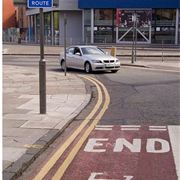WITH petrol around six quid a gallon, more people will be forced to switch to alternative modes of travel. Trains are good if you live close to a station, buses are, well buses.
After walking, the faithful, push bike is the cheapest option there is. But are you risking life and limb every time you slap on those bicycle clips?
What is needed is a proper solution – demolish swathes of the entire city and rebuild with wide cycle lanes, separated from generally unsympathetic car drivers with wide, green verges
Liverpool City Council is being asked to adopt a cycling manifesto, first flagged up by The Times newspaper, to make cities safer for bike riders, with a cycling Tsar to ensure the policy is a runner.
Liverpool probably ticks many of the boxes for its cycle routes and cycle lanes.
 Inadequate: A cycle lane
Inadequate: A cycle lane
in LiverpoolThe problem is two-wheel commuters have to rub shoulders (literally) with heavy traffic, and even some of those narrow cycle lanes, essentially roadside gutters, are potentially hazardous.
What is needed is a proper solution – demolish swathes of the entire city and rebuild with wide cycle lanes, separated from motorised and generally unsympathetic drivers, with wide green verges. But that's never going to happen.
Many of the roads in Liverpool are incapable of being cycle friendly, simply because there isn't enough road space to facilitate proper segregation.
In another life - and on another continent - I owned three bikes, conveniently parked at strategic points, there when I needed them. Cycling along wide, shrub-lined cycle lanes, looking at vehicles gridlocked in the multi-lane ring roads, the cycle ruled, OK.
What Liverpool doesn't need is a certificate crowing about its high number of cycle lane kilometres. Each cycle lane needs to be graded – like A routes or B routes, so we can distinguish safe routes for strips of road that are mere excuses for a cycle lane.
The call for a manifesto comes from Lib Dem group leader Paula Keaveney and will come before the city council on Wednesday (March 14).
She says would-be cyclists are put off using a bike because of real or perceived dangers. She wants the council's regeneration cabinet member Malcolm Kennedy to sign up on behalf of the city for the eight-point manifesto.
Even if it is supported, it won't have much of an impact. Who can stop cars parking in cycle lanes when it suits them? Where can the space be found to provide meaningful, safe and segregated cycle routes?
 On the waterfront (pic courtesy
On the waterfront (pic courtesy
of Critical MassOtterspool Promenade and the river front has become popular with city-centre bound commuters, providing an virtually exclusive off-road route from Garston to the Pier Head. Some of those cyclists, because of their speed, present a danger to pedestrians strolling along the prom.
What about cyclists who don't realise a red traffic light means they should halt as well.
One of the eight points in the manifesto is the call for Liverpool to have its own cycling commissioner. That person, if appointed, will only succeed depending on a chain (excuse the pun) of command.
Sadly, for the forseeable future, the vast majority of commuters will stick to the car.
Bring in Son of Big Dig, raise parking charges, up the price of fuel to £20 a gallon and it will still rule the roads of Liverpool.
The reason: it's dangerous on those roads.
Here are the eight points of the manifesto....
1. Lorries entering a city centre should be required by law to fit sensors, audible turning alarms, extra mirrors and safety bars to stop cyclists being thrown under the wheels.
 Pic courtesy of Critical Mass
Pic courtesy of Critical Mass
2. The 500 most dangerous road junctions must be identified, redesigned or fitted with priority traffic lights for cyclists and Trixi mirrors that allow lorry drivers to see cyclists on their near-side.
3. A national audit of cycling to find out how many people cycle in Britain and how cyclists are killed or injured should be held to underpin effective cycle safety.
4. Two per cent of the Highways Agency budget should be earmarked for nexts generation cycle routes, providing £100 million a year towards world-class cycling infrastructure. Each year cities should be graded on the quality of cycling provision.
5. The training of cyclists and drivers must improve and cycle safety should become a core part of the driving test.
6. 20mph should become the default speed limit in residential areas where there are no cycle lanes.
7. Businesses should be invited to sponsor cycleways and cycling super-highways, mirroring the Barclays-backed bicycle hire scheme in London.
8. Every city should appoint a cycling commissioner to push home reforms.















